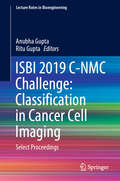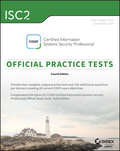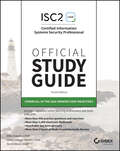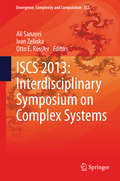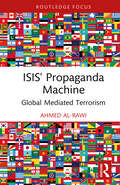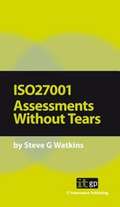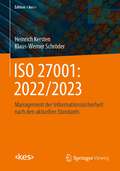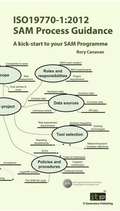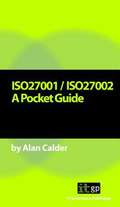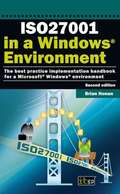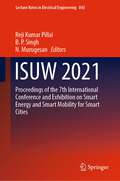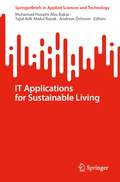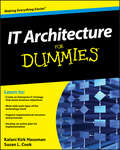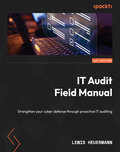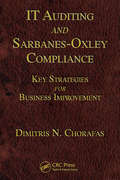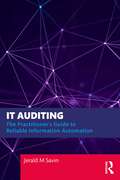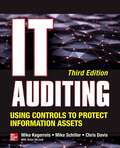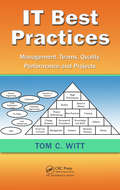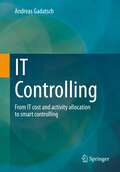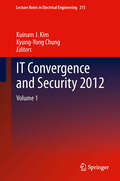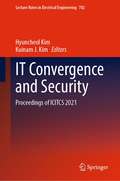- Table View
- List View
ISBI 2019 C-NMC Challenge: Select Proceedings (Lecture Notes in Bioengineering)
by Anubha Gupta Ritu GuptaThis book comprises select peer-reviewed proceedings of the medical challenge - C-NMC challenge: Classification of normal versus malignant cells in B-ALL white blood cancer microscopic images. The challenge was run as part of the IEEE International Symposium on Biomedical Imaging (IEEE ISBI) 2019 held at Venice, Italy in April 2019. Cell classification via image processing has recently gained interest from the point of view of building computer-assisted diagnostic tools for blood disorders such as leukaemia. In order to arrive at a conclusive decision on disease diagnosis and degree of progression, it is very important to identify malignant cells with high accuracy. Computer-assisted tools can be very helpful in automating the process of cell segmentation and identification because morphologically both cell types appear similar. This particular challenge was run on a curated data set of more than 14000 cell images of very high quality. More than 200 international teams participated in the challenge. This book covers various solutions using machine learning and deep learning approaches. The book will prove useful for academics, researchers, and professionals interested in building low-cost automated diagnostic tools for cancer diagnosis and treatment.
ISC2 CISSP Certified Information Systems Security Professional Official Practice Tests (Sybex Study Guide Ser.)
by David Seidl Mike ChappleFull-length practice tests covering all CISSP domains for the ultimate CISSP prep The ISC2 CISSP Official Practice Tests is a major resource for ISC2 Certified Information Systems Security Professional (CISSP) candidates, providing 1300 unique practice questions. The first part of the book provides 100 questions per domain. You also have access to four unique 125-question practice exams to help you master the material. As the only official practice tests endorsed by ISC2, this book gives you the advantage of full and complete preparation. These practice tests align with the 2024 version of the CISSP Detailed Content Outline to ensure up-to-date preparation, and are designed to cover what you will see on exam day. Coverage includes: Security and Risk Management, Asset Security, Security Architecture and Engineering, Communication and Network Security, Identity and Access Management (IAM), Security Assessment and Testing, Security Operations, and Software Development Security. The CISSP credential signifies a body of knowledge and a set of guaranteed skills that put you in demand in the marketplace. This book is your ticket to achieving this prestigious certification, by helping you test what you know against what you need to know. Test your knowledge of the 2024 CISSP domains Identify areas in need of further study Gauge your progress throughout your study and preparation Practice test taking with Sybex’s online test environment containing the questions from the book The CISSP objectives are refreshed every few years to ensure that candidates are up-to-date on the latest security topics and trends. Currently-aligned preparation resources are critical, and periodic practice tests are one of the best ways to truly measure your level of understanding.
ISC2 CISSP Certified Information Systems Security Professional Official Study Guide (Sybex Study Guide)
by Darril Gibson Mike Chapple James Michael StewartCISSP Study Guide - fully updated for the 2024 CISSP Body of Knowledge ISC2 Certified Information Systems Security Professional (CISSP) Official Study Guide, 10th Edition has been completely updated based on the latest 2024 CISSP Detailed Content Outline. This bestselling Sybex Study Guide covers 100% of the CISSP objectives. You'll prepare smarter and faster with Sybex thanks to expert content, knowledge from our real-world experience, access to the Sybex online interactive learning environment, and much more. Reinforce what you've learned with key topic Study Essentials and chapter review questions. The book’s co-authors bring decades of experience as cybersecurity practitioners and educators, integrating real-world expertise with the practical knowledge you'll need to successfully prove your CISSP mastery. Combined, they've taught cybersecurity concepts to millions of students through their books, video courses, and live training programs. Along with the book, you also get access to Sybex's superior online interactive learning environment that includes: Over 900 practice test questions with complete answer explanations. This includes all of the questions from the book plus four additional online-only practice exams, each with 125 unique questions. You can use the online-only practice exams as full exam simulations. Our questions will help you identify where you need to study more. More than 1000 Electronic Flashcards to reinforce your learning and give you last-minute test prep A searchable glossary in PDF to give you instant access to the key terms you need to know Audio Review. Author Mike Chapple reads the Study Essentials for each chapter providing you with more than 2 hours of up-to-date audio review for yet another way to reinforce your knowledge as you prepare. Coverage of all of the CISSP topics in the book means you'll be ready for: Security and Risk Management Asset Security Security Architecture and Engineering Communication and Network Security Identity and Access Management (IAM) Security Assessment and Testing Security Operations Software Development Security
ISCS 2013: Interdisciplinary Symposium on Complex Systems
by Ivan Zelinka Ali Sanayei Otto E. RösslerThe book you hold in your hands is the outcome of the "ISCS 2013: Interdisciplinary Symposium on Complex Systems" held at the historical capital of Bohemia as a continuation of our series of symposia in the science of complex systems. Prague, one of the most beautiful European cities, has its own beautiful genius loci. Here, a great number of important discoveries were made and many important scientists spent fruitful and creative years to leave unforgettable traces. The perhaps most significant period was the time of Rudolf II who was a great supporter of the art and the science and attracted a great number of prominent minds to Prague. This trend would continue. Tycho Brahe, Niels Henrik Abel, Johannes Kepler, Bernard Bolzano, August Cauchy Christian Doppler, Ernst Mach, Albert Einstein and many others followed developing fundamental mathematical and physical theories or expanding them. Thus in the beginning of the 17th century, Kepler formulated here the first two of his three laws of planetary motion on the basis of Tycho Brahe's observations. In the 19th century, nowhere differentiable continuous functions (of a fractal character) were constructed here by Bolzano along with a treatise on infinite sets, titled "Paradoxes of Infinity" (1851). Weierstrass would later publish a similar function in 1872. In 1842, Doppler as a professor of mathematics at the Technical University of Prague here first lectured about a physical effect to bear his name later. And the epoch-making physicist Albert Einstein - while being a chaired professor of theoretical physics at the German University of Prague - arrived at the decisive steps of his later finished theory of general relativity during the years 1911-1912. In Prague, also many famous philosophers and writers accomplished their works; for instance, playwright arel ape coined the word "robot" in Prague ("robot" comes from the Czech word "robota" which means "forced labor").
ISIS' Propaganda Machine: Global Mediated Terrorism
by Ahmed Al-RawiThis book examines ISIS’ media propaganda machine.The book focuses on case studies that have been largely understudied in relation to ISIS’ media production. Empirically, it offers new insights into how ISIS uses its media production to disseminate its extremist ideology by focusing on video games, educational apps, Dark Web sites, and offline billboards. The book argues that despite all the discussion about how ISIS has disappeared or even died, the terrorist group’s daily activities on the Dark Web show that they are still thriving and disseminating their propaganda in more than 20 different languages, and effectively functioning as an international news organization. Using a mixed-method research approach, the book offers a multilayered understanding of media content and fills a major gap in the literature, especially in relation to the use of educational apps and the Dark Web.This book will be of much interest to students of media and communication studies, terrorism and counterterrorism, Middle Eastern politics, and international relations.
ISO 27001 Assessments Without Tears: A Pocket Guide
by Steve G WatkinsThe audit process can be a daunting one as an auditor can direct questions at any employee within your organization. Written in a clear plain style, this pocket guide offers a tried and tested briefing, and should be issued to staff in advance of the audit to help them prepare for the experience and be well equipped to answer questions when asked. This pocket book explains what an ISO 27001 assessment is, why organizations bother with them, and what individual staff should do and, perhaps as importantly, not do if an auditor chooses to question them.
ISO 27001: Management der Informationssicherheit nach den aktuellen Standards (Edition <kes>)
by Heinrich Kersten Klaus-Werner SchröderEin qualifiziertes Management der Informationssicherheit ist heutzutage für jede Organisation unverzichtbar. Die Normenreihe ISO 27000 ist dabei ein anerkannter „Wegweiser“ zu diesem Ziel. Im internationalen Kontext ist ihre Erfüllung für viele Organisationen ein wichtiger Wettbewerbsfaktor. Auch in Deutschland hat diese Normenreihe Eingang in Vorgaben, Regelungen und Gesetze zum Thema Informationssicherheit gefunden.Das vorliegende Buch kommentiert vor diesem Hintergrund die aktuellen Normen ISO 27001 und ISO 27002 (Ausgabe 2022/2023): Nach einer Einführung in die Normenreihe und ihren Fachbegriffen werden die Anforderungen an das Managementsystem für Informationssicherheit (ISMS) detailliert erklärt und mit zahlreichen Hinweise zur Umsetzung versehen. Im Anhang der ISO 27001 sind die sog. Controls aufgeführt, die in der neuen Normfassung komplett umstrukturiert und an vielen Stellen geändert wurden. Das Buch behandelt ausführlich alle Controls und gibt viele Beispiele für ihre Anwendung.Mit dem Erscheinen der neuen Normfassungen müssen sich viele Organisationen entsprechend umstellen – nicht zuletzt auch im Zusammenhang mit Zertifizierungen. Das Buch bietet hier einen ausführlichen Fahrplan zur Migration auf die neuen Normen.
ISO/IEC 20000 An introduction to the global standard for service management
by David CliffordManage your IT services more effectively This pocket guide will show you how. Whatever your business, your capacity to supply products and services to your customers depends on your IT. Yet, all too often, companies and government departments fail to take effective control of their IT systems. Instead, organisations rely on a confused mish-mash of different technologies and ad hoc working practices. The solution: an ITSMS To avoid this fate, your organisation needs to adopt an IT Service Management System (ITSMS). Employing an ITSMS will enable your organisation to identify how to enhance the quality of service you deliver to your customers. The standard for an ITSMS is ISO/IEC 20000. ISO/IEC 20000 The standard This pocket guide offers an overview of the purpose of the standard and shows how it can be used. Topics covered include qualification programmes, certification schemes and the interrelationship of ISO20000 with other standards, such as ISO27001. The overall emphasis of the guide is on ISO20K s customer-driven approach, ensuring your IT service management processes will be aligned with the needs of your business. Benefits to business include: * Deliver on the commitments you have made. When you provide services to a customer, the customer expects you to take responsibility for completing the job on time. From your perspective, the way you deal with your suppliers plays a vital role in fulfilling that objective. Implementing ISO20000 entails adopting a holistic approach to service development and delivery, enabling prompt and accurate communication between your organisation and your suppliers. By managing relationships with your suppliers, you can establish a strong supply chain that will be capable of delivering on the commitments you have made. * More efficient and effective service delivery. Different divisions and departments are a fact of life in every organisation. The problem is how to get them working together. Without proper communication between your employees, you cannot get them to cooperate. By adopting ISO20000, employee coordination can be improved and you can protect your organisation from the risk of different business units turning into information silos. Measures, such as showing appreciation for actions that promote integration, and using key performance indicators that encourage measurement across the departmental divide, will foster team spirit and lead to more efficient and effective service delivery. * Strengthen relationships and win new business. You can improve the running of your business simply by using ISO20000 as a checklist of activities that need to be performed. However, there are many advantages to achieving formal certification. In particular, it will help you to strengthen your relationships with existing customers and to win new business. If you are a service provider, certification to ISO20000 is an opportunity to demonstrate the quality and reliability of your service management capability to existing and potential customers. * Win new contracts. For a service provider, certification to ISO20000 can open doors and help you bid for new orders. Sometimes, a customer organisation may make certification to ISO20000 a requirement when awarding a particular contract. When businesses devote too little time to researching or planning how they deal with customers, the quality of service they provide will inevitably suffer, as they find themselves reacting to problems rather than devising a solution to them. In the long run, the silo-based mentality leads to a decline in the quality of service the organisation can provide, undermining relationships with customers and making it harder to forge new partnerships or win new business. This pocket guide contains invaluable advice on how to define the appropriate scope for assessment against ISO20000 and how the service management activities are audited using test data. It will enable you to ensure your IT service management processes align with the needs of your business and ultimately grow your business by...
ISO27000 and Information Security: A Combined Glossary
by Steve G Watkins Alan CalderGet to grips with key ISO27000 and information security vocabulary with this indispensable, concise pocket guide! Information security is of crucial importance to your business. If you don t know the difference between a cookie and a worm, or between war-chalking and digital watermarking, you are sure to find this guide enlightening. The strength of the book is that it is a combined glossary, enabling you to find explanations of geek slang, procedural language and acronyms all in one place. The combined glossary is a revised edition of the popular A Dictionary of Information Security Terms, and this new edition has been able to draw on the definitions provided in ISO/IEC 27000:2009 Security Techniques Information security management systems Overview and vocabulary. What's new? Further definitions are sourced from ISO/IEC Guide 73:2002 to provide you with authoritative explanations of those information security terms that are used across the ISO framework. The combined glossary has taken account of an important change on the information security scene, and contains some new acronyms and definitions from the Payment Card Industry Data Security Standard (PCI DSS). Benefits to business include: * Understand what everyone else is talking about The fact that you re reading this suggests you take an interest in information security. Whether you work in business or in the public sector, it s an issue that s likely to come up. If you re given a position paper to read on information security, or have to attend a briefing, you will want to form your own opinion, particularly when the discussion directly affects your company. Meekly accepting arguments you don t understand is never a good idea, especially not when large sums of money are involved. With the clear, reliable definitions contained in this combined glossary, you can finally get to grips with the problem. * Understand what you re talking about Any modern organisation relies on its IT systems. Although IT may not be your speciality, cybercrime affects all of us. So, wherever you work, if you are in a position of responsibility, then at some point, you will need to form a view on information security and put your point across. You can use this combined glossary to bring your arguments into sharper focus. The pocket guide will prove invaluable not only to business executives but also to civil servants and lawyers, as well as to people working in financial services and the media. * Assist ISO implementation If your company or department is introducing an information security management system (ISMS) as specified under ISO27001, then you can ensure that key personnel are up to speed on the issue of information security by giving them all a copy of this pocket guide. * Make better decisions The bad guys are only ever a mouse-click away. If you care at all about the financial well-being of your company, you need to take action on information security. However, there is often a gap between management s overall sense of its responsibilities regarding information security and the IT people whose technical skills are required to fulfil those obligations. This combined glossary will help your organisation to bridge that gap and to facilitate communication between managers and the IT department. The guide enables managers to grasp the key concepts of information security, thereby facilitating the planning and coordination that are essential for successful implementation of any major information security project. So it makes sense to take information security seriously, even if you are not an expert on the subject. This rapidly evolving discipline has spawned a complex and bewildering vocabulary and understanding the terms and language will stand you in good stead. If you have ever felt confused by the language of information security, this pocket guide is for you; designed for non-specialist managers and those who are new to the subject, two internationally recognised experts in the field of information security have created a simple key to the mysteries of geek speak.
ISO27001 / ISO27002 A Pocket Guide
by Alan CalderISO/IEC 27001:2005 is an international standard for information security management systems (ISMSs). Closely allied to ISO/IEC 27002:2005 (which used to be known as ISO17799), this standard (sometimes called the ISMS standard) can help organizations meet all their information-related regulatory compliance objectives and can help them prepare and position themselves for new and emerging regulations. Information is the lifeblood of modern organizations and, therefore, ensuring that information is simultaneously protected and available to those who need it is essential to modern business operations. Information systems are not usually designed from the outset to be secure. Technical security measures and checklists are limited in their ability to protect a complete information system. Management systems and procedural controls are essential components of any really secure information system and, to be effective, need careful planning and attention to detail. ISO/IEC 27001 provides the specification for an information security management system and, in the related Code of Practice, ISO/IEC 27002, it draws on the knowledge of a group of experienced information security practitioners in a wide range of significant organizations across more than 40 countries to set out best practice in information security. An ISO27001-compliant system will provide a systematic approach to ensuring the availability, confidentiality and integrity of corporate information. The controls of ISO27001 are based on identifying and combating the entire range of potential risks to the organizations information assets. This helpful, handy ISO27001/ISO27002 pocket guide gives a useful overview of these two important information security standards.
ISO27001 in a Windows® Environment
by Brian HonanA fundamental title that should be part of every information security practitioner''s technical library!The vast majority of ISO27001 implementations will, to one extent or another, take place in a Windows environment. ISO27001 project managers are not always Microsoft technical experts, but a large number of the ISO27001 controls require a technical implementation. Bridging the gap between non-technical ISO27001 project managers and IT specialists, this book explains what the controls are, and describes how to implement them in a Windows environment, equipping the ISO27001 project manager to succeed with the implementation. MCSEs who have security training (MCSE Security), but who may not understand the ISO27001 approach to selecting and implementing controls, will also benefit from this book. It provides them with the necessary rationale and links their technical understanding of Microsoft information security controls into the international best practice framework for information security. This book should be a core part of the technical library of every MCSE and information security practitioner. If you have a CISSP, CISM, GIAC, or another professional certification, you should read this book. Covering best practice implementation over a wide range of Windows® environments, this second edition is completely up to date for Windows® 7 and Server® 2008. Benefits to business include: * Enable successful implementation Although ISO27001 project managers are seldom Microsoft technical experts, a large number of the ISO27001 Annexe A controls demand a technical implementation. Now, thanks to this book, project managers can finally give a clear explanation to their technical people of what is required under ISO27001. Armed with this guide, a project manager will find it much easier to succeed with implementation of ISO27001 * Help security engineers to understand ISO27001 ISO27001 is the international best practice framework for information security. However, because ISO27001 takes a business risk approach, it is unfamiliar territory to many Microsoft Certified Systems Engineers (MCSEs), even if they already have security training (MCSE Security). With this book, MSCEs can fill a gap in their knowledge and thereby harness their technical understanding of the Microsoft information security controls to drive through implementation of ISO27001 * Improve security and reliability. The purpose of ISO27001 is to ensure the confidentiality, integrity and availability of your business information. By putting suitable controls in place you can achieve these "CIA" goals. In this way you will also make your storage and handling of data more reliable * Take advantage of the tools you already have to hand. Since Microsoft products are so widely used, the technical details in this book are based on the Microsoft Windows® platform. This book shows IT managers how to make effective use of the Microsoft technologies at their disposal to support implementation of ISO27001. As a result, your organisation should be able to achieve certification without having to buy additional third-party software. Security improvements from MicrosoftMicrosoft''s latest desktop operating system, Windows® 7, comes with many security improvements. You can use these to help you to develop an ISMS that complies with ISO27001. One of these features is BitLocker, an encrypting system that allows you to encrypt individual files and folders. You can also encrypt the entire contents of a computer''s hard disk to make the data stored on it unavailable to unauthorised personnel. BitLocker To Go enables you to transport information securely from one system to another using portable devices such as a USB. Another feature of Windows 7, AppLocker, will allow your organisation to restrict the applications available to a user on a desktop. By preventing improper use of key applications by your staff, AppLocker can help your organisation to reduce security risks. This guide provides the IT manager with a detailed breakdown of the various controls requir...
ISUW 2021: Proceedings of the 7th International Conference and Exhibition on Smart Energy and Smart Mobility for Smart Cities (Lecture Notes in Electrical Engineering #843)
by Reji Kumar Pillai B. P. Singh N. MurugesanThis book presents selected articles from INDIA SMART UTILTY WEEK (ISUW 2021), which is the seventh edition of the Conference cum Exhibition on Smart Grids and Smart Cities, organized by India Smart Grid Forum from 02-05 March 2021, in New Delhi, India. ISGF is a public private partnership initiative of the Ministry of Power, Govt. of India with the mandate of accelerating smart grid deployments across the country. This book gives current scenario updates of Indian power sector business. It also highlights various disruptive technologies for power sector business.
IT Applications for Sustainable Living (SpringerBriefs in Applied Sciences and Technology)
by Andreas Öchsner Muhamad Husaini Abu Bakar Tajul Adli Abdul RazakThe Internet of Things (IoT) has emerged as a new paradigm that connects the physical world with the digital world. It is a network of interconnected devices, sensors, and objects that can communicate with each other, collect and exchange data, and perform various tasks without human intervention. The IoT has the potential to revolutionize various industries, such as healthcare, transportation, manufacturing, and agriculture, by enabling real-time monitoring, automation, and optimization of processes. This book is a collection of research manuscripts that explores the latest developments in smart technologies for sustainable living with reference to the IoT landscape, including its architecture, applications and challenges. The research covers a wide range of topics including character segmentation, recognition and classification, deep learning, smart home, earthquake early-warning system, wireless sensor network, embedded RFID system and many more. It also discusses various IoT platforms, protocols, and standards that are being developed to enable seamless integration and interoperability of IoT devices and services. The research book aims to become a valuable resource for researchers, practitioners, and policymakers interested in smart technologies and sustainable living.
IT Architecture For Dummies
by Kalani Kirk Hausman Susan L. CookA solid introduction to the practices, plans, and skills required for developing a smart system architecture Information architecture combines IT skills with business skills in order to align the IT structure of an organization with the mission, goals, and objectives of its business. This friendly introduction to IT architecture walks you through the myriad issues and complex decisions that many organizations face when setting up IT systems to work in sync with business procedures. Veteran IT professional and author Kirk Hausman explains the business value behind IT architecture and provides you with an action plan for implementing IT architecture procedures in an organization. You'll explore the many challenges that organizations face as they attempt to use technology to enhance their business's productivity so that you can gain a solid understanding of the elements that are required to plan and create an architecture that meets specific business goals. Defines IT architecture as a blend of IT skills and business skills that focuses on business optimization, business architecture, performance management, and organizational structure Uncovers and examines every topic within IT architecture including network, system, data, services, application, and more Addresses the challenges that organizations face when attempting to use information technology to enable profitability and business continuity While companies look to technology more than ever to enhance productivity, you should look to IT Architecture For Dummies for guidance in this field.
IT Asset Management A Pocket Survival Guide
by Martyn HobbsIT Asset Management: A Pocket Survival Guideis a quick reference style guide, addressing such serious issues with a fresh and pragmatic approach. Aimed at IT professionals who have been tasked with putting in place Asset Management disciplines, it first provides a commonsense introduction to the key processes outlined in the Information Technology Infrastructure Library (ITIL(r)), before proceeding to explain the various milestones of an Asset Management projec
IT Audit Field Manual: Strengthen your cyber defense through proactive IT auditing
by Lewis HeuermannMaster effective IT auditing techniques, from security control reviews to advanced cybersecurity practices, with this essential field manualKey FeaturesSecure and audit endpoints in Windows environments for robust defenseGain practical skills in auditing Linux systems, focusing on security configurations and firewall auditing using tools such as ufw and iptablesCultivate a mindset of continuous learning and development for long-term career successPurchase of the print or Kindle book includes a free PDF eBookBook DescriptionAs cyber threats evolve and regulations tighten, IT professionals struggle to maintain effective auditing practices and ensure robust cybersecurity across complex systems. Drawing from over a decade of submarine military service and extensive cybersecurity experience, Lewis offers a unique blend of technical expertise and field-tested insights in this comprehensive field manual. Serving as a roadmap for beginners as well as experienced professionals, this manual guides you from foundational concepts and audit planning to in-depth explorations of auditing various IT systems and networks, including Cisco devices, next-generation firewalls, cloud environments, endpoint security, and Linux systems. You’ll develop practical skills in assessing security configurations, conducting risk assessments, and ensuring compliance with privacy regulations. This book also covers data protection, reporting, remediation, advanced auditing techniques, and emerging trends. Complete with insightful guidance on building a successful career in IT auditing, by the end of this book, you’ll be equipped with the tools to navigate the complex landscape of cybersecurity and compliance, bridging the gap between technical expertise and practical application.What you will learnEvaluate cybersecurity across AWS, Azure, and Google Cloud with IT auditing principlesConduct comprehensive risk assessments to identify vulnerabilities in IT systemsExplore IT auditing careers, roles, and essential knowledge for professional growthAssess the effectiveness of security controls in mitigating cyber risksAudit for compliance with GDPR, HIPAA, SOX, and other standardsExplore auditing tools for security evaluations of network devices and IT componentsWho this book is forThe IT Audit Field Manual is for both aspiring and early-career IT professionals seeking a comprehensive introduction to IT auditing. If you have a basic understanding of IT concepts and wish to develop practical skills in auditing diverse systems and networks, this book is for you. Beginners will benefit from the clear explanations of foundational principles, terminology, and audit processes, while those looking to deepen their expertise will find valuable insights throughout.
IT Auditing and Sarbanes-Oxley Compliance: Key Strategies for Business Improvement
by Dimitris N. ChorafasInformation technology auditing and Sarbanes-Oxley compliance have several overlapping characteristics. They both require ethical accounting practices, focused auditing activities, a functioning system of internal control, and a close watch by the board's audit committee and CEO. Written as a contribution to the accounting and auditing professions
IT Auditing: The Practitioner's Guide to Reliable Information Automation
by Jerald SavinMore than ever, technology is indispensable to business operations and recordkeeping, so people skilled in computer automation — IT auditors — have become an essential part of the financial audit team.This book is a comprehensive guide to the IT audit discipline, and to the impact of abstraction on businesses. Developments including Robotic Process Automation (RPA) and artificial intelligence (AI) mean that businesses are moving from a physical world to an abstracted digital world, increasing reliance on systems, their design, their implementation and on those that oversee and maintain these systems — often parties outside the businesses’ control. Though the implications of these shifts go far beyond IT auditing, this book focuses on what IT auditors need to know in this new environment, such as:• How to understand abstracted services and appropriate internal business controls• How to evaluate situations where physicality has been replaced by abstracted services• How to understand and adapt to the impact of abstracted services on objectives, operations, decision-making, and Risk Management, including changing risk profiles and introducing new risks.In the wake of the Certified Public Accountant (CPA) Evolution project, this book will be an essential resource for readers seeking CPA certification, as well as for business leaders and Risk Management professionals who need to understand the benefits and challenges of ever-increasing automation and its concurrent abstraction of physical reality.
IT Auditing: Using Controls to Protect Information Assets
by Chris Davis Mike Kegerreis Mike SchillerSecure Your Systems Using the Latest IT Auditing Techniques <p><p>Fully updated to cover leading-edge tools and technologies, IT Auditing: Using Controls to Protect Information Assets, Third Edition, explains, step by step, how to implement a successful, enterprise-wide IT audit program. New chapters on auditing cybersecurity programs, big data and data repositories, and new technologies are included. This comprehensive guide describes how to assemble an effective IT audit team and maximize the value of the IT audit function. In-depth details on performing specific audits are accompanied by real-world examples, ready-to-use checklists, and valuable templates. Standards, frameworks, regulations, and risk management techniques are also covered in this definitive resource.
IT Best Practices: Management, Teams, Quality, Performance, and Projects
by Tom C. WittConsistent success does not happen by chance. It occurs by having an understanding of what is happening in the environment and then having the skills to execute the necessary changes. Ideal for project, IT, and systems development managers, IT Best Practices: Management, Teams, Quality, Performance, and Projects details the skills, knowledge, and a
IT Controlling: From IT cost and activity allocation to smart controlling
by Andreas GadatschIT controlling is established as a tool for controlling information technology. The job description of the IT controller has changed only moderately over a long period of time. It was mainly associated with IT budgeting, IT portfolio management, IT cost planning, accounting and controlling. However, digitalization has brought movement in goals, contents and methods. New topics such as digital strategy management, cloud controlling, data science, etc. are being discussed. The task profile is changing away from pure IT cost analysis to the management of the digitization strategy with a focus on strategic IT portfolio management. Some voices are already talking about "smart controlling" or "digital controlling". This book presents an IT controlling concept for the digital age and explains the relevant methods in a practical way.
IT Convergence and Security 2012
by Kuinam J. Kim Kyung-Yong ChungThe proceedings approaches the subject matter with problems in technical convergence and convergences of security technology. This approach is new because we look at new issues that arise from techniques converging. The general scope of the proceedings content is convergence security and the latest information technology. The intended readership are societies, enterprises, and research institutes, and intended content level is mid- to highly educated personals. The most important features and benefits of the proceedings are the introduction of the most recent information technology and its related ideas, applications and problems related to technology convergence, and its case studies and finally an introduction of converging existing security techniques through convergence security. Overall, through the proceedings, authors will be able to understand the most state of the art information strategies and technologies of convergence security.
IT Convergence and Security: Proceedings of ICITCS 2020 (Lecture Notes in Electrical Engineering #712)
by Kuinam J. Kim Hyuncheol KimThis volume comprises the proceedings of ICITCS 2020. It aims to provide a snapshot of the latest issues encountered in IT convergence and security. The book explores how IT convergence and security is core to most current research, industrial and commercial activities. Topics covered in this volume include machine learning & deep learning, communication and signal processing, computer vision and applications, future network technology, artificial intelligence and robotics, software engineering and knowledge engineering, intelligent vehicular networking and applications, healthcare and wellness, web technology and applications, internet of things, and security & privacy. Through this volume, readers will gain an understanding of the current state-of-the-art information strategies and technologies in IT convergence and security. The book will be of use to researchers in academia, industry and other research institutes focusing on IT convergence and security.
IT Convergence and Security: Proceedings of ICITCS 2021 (Lecture Notes in Electrical Engineering #782)
by Kuinam J. Kim Hyuncheol KimThis book comprises the proceedings of ICITCS 2021. It aims to provide a snapshot of the latest issues encountered in IT convergence and security. The book explores how IT convergence and security are core to most current research, industrial, and commercial activities. Topics covered in this book include machine learning & deep learning, communication and signal processing, computer vision and applications, future network technology, artificial intelligence and robotics, software engineering and knowledge engineering, intelligent vehicular networking and applications, health care and wellness, web technology and applications, Internet of things, and security & privacy. Through this book, readers gain an understanding of the current state-of-the-art information strategies and technologies in IT convergence and security. The book is of use to researchers in academia, industry, and other research institutes focusing on IT convergence and security.
